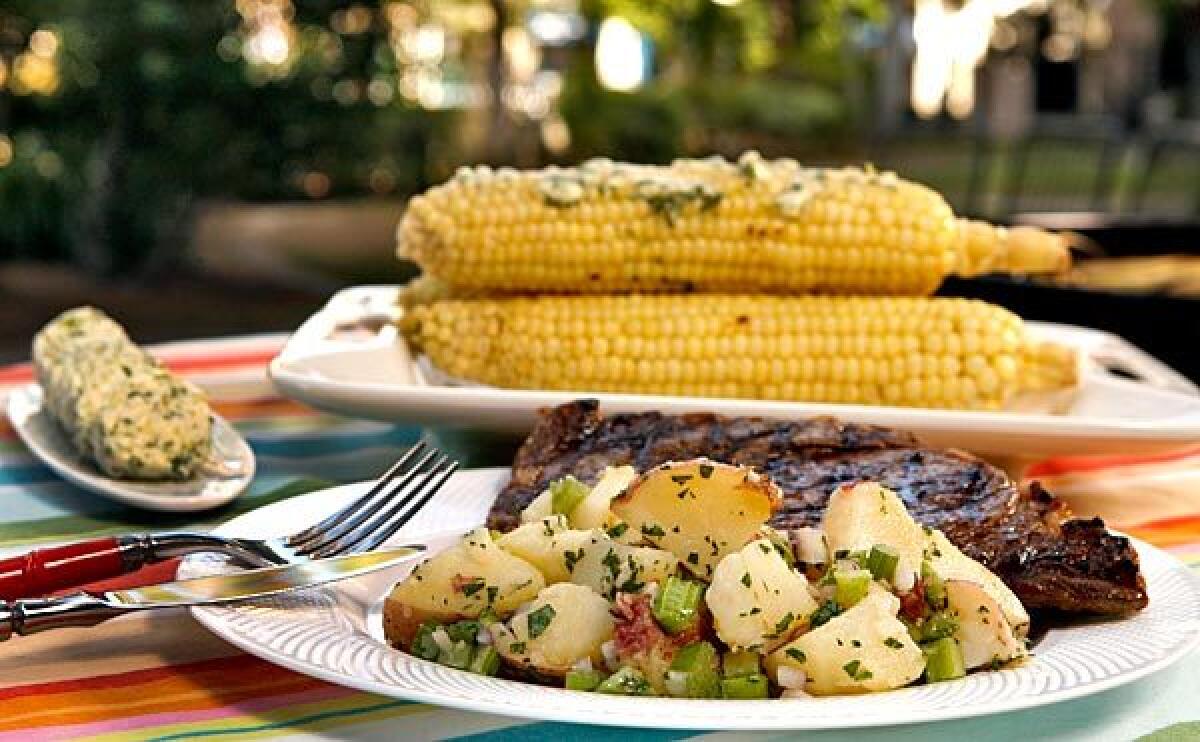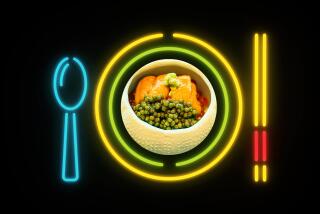The California Cook: How to grill the perfect steak

Ah, the first warm days of summer, when some mysterious force compels even the most hapless cooks to start a fire and burn some meat. Walking around my neighborhood last weekend, the smell of flaming beef fat was everywhere.
It made me wonder: Really, how hard can it be to grill a good steak?
You shouldn’t even need a recipe. Take a good piece of meat (bright red color, nice flecks of white fat inside the muscle, not just around it, at least an inch thick), season it simply (salt and pepper, that’s it) and put it on the grill over a moderately hot fire (not too hot or it’s “Towering Inferno” time — when you can hold your hand about 5 or 6 inches over the grill for four or five seconds, that’s right).
Beyond that, it’s all detail. But, as in anything, those details are exactly what make the difference between good and great. Fortunately with a steak dinner, they’re really pretty simple, even if they can be a bit geeky.
Start with the steak. The first step is seasoning it at the right time. Do it before cooking, not after. To demonstrate how much of a difference this makes, I bought three boneless rib-eyes, each cut about 1 inch thick and weighing about 11/4 pounds. I seasoned each with 1 teaspoon of kosher salt distributed evenly over both sides. One was salted an hour before cooking, one was salted just before cooking and one was salted immediately after cooking.
The difference among the steaks was the degree of saltiness against the underlying flavor. The steak seasoned an hour early didn’t taste quite as salty as the others, but it had a subtler, more developed meat flavor. The steak seasoned just before grilling was a little more overtly salty even if the meat flavor wasn’t quite as complex. The steak salted after cooking was the saltiest — so much so that the meat seemed kind of bland by comparison.
I also wanted to test a new theory of turning I’d heard about. Normally, when I cook a steak, it’s pretty basic — cook the steak a couple of minutes on one side, turn it 90 degrees to get nice hash marks, then repeat on the other side. That’s just one flip and a couple of cosmetic rotations.
But food science writer Harold McGee has proposed another technique using more frequent flips. In fact, he tried it turning the steak as frequently as every five seconds, a feat on the level of juggling plates. I was curious, but not quite that curious, so I cut it back to a flip a minute.
I found it actually works pretty well. Not only did the meat cook more evenly (on a cut slice, the outer “well-done” edge was equally thick on both sides), but the final result had developed a nice brown crust that was equal to the comparison steak I fixed alongside using the one-flip method. Curiously, it also seemed to cook more quickly, something McGee had also observed. Finally, while the one-flip rib-eyes all seemed to curl during cooking (a result of the outer muscle shrinking before the inner muscle), the frequent flipper came off the grill nice and flat.
Another key point is being sure to let the cooked meat rest before you carve it. This reduces the amount of moisture that is lost, and it makes your steak juicier and more flavorful. While the rest can be anywhere from 15 to 30 minutes with large cuts such as roasts, with a steak, even as little as 5 minutes on the cutting board before carving will make a difference in how much meat juice leaks out.
Don’t take my word for it. If you want a vivid demonstration, visit the Food Lab section at the website Serious Eats, run by the joyously nerdy J. Kenji Alt ( MIT trained — need I say more?). Alt found that a steak carved immediately after it came off the fire had lost 22% of its initial weight. A rest of only 21/2 minutes cut that to 19%, and 5 minutes reduced it to 16%, after which the curve bottomed out at 15% (meat unavoidably loses a certain amount of weight during cooking — Alt figures 13% — even before the juices lost during carving are figured in).
Lord help me, I love this stuff.
There’s more to dinner — even a steak dinner — than meat. Every cook — aspiring burger flipper or hardwood Zen master — needs to have a potato salad in his or her repertoire. Or preferably a few of them.
A well-made potato salad is one of the most delicious side dishes you can have. So why are so many of them so forgettable? Here I go getting geeky again. There are two related reasons. The first is a lack of acidity. Potatoes have a rich, earthy flavor that really needs a good bit of tartness (vinegar, lemon juice, etc) to provide structure.
But it’s also important when you add that acidity. Season while the potatoes are still hot, even if you’re going to serve the dish cold. This is because as the starch on the outside of the potato cools, it hardens and keeps any seasoning from reaching to the center. Season while the potatoes are still slightly steaming and they’ll be flavorful all the way through.
The seasoning can be simply oil and vinegar or it can be a more complicated vinaigrette. I like a little minced shallot to sharpen the flavor. Potato salad is terrific with blanched green beans stirred in, or you can go crunchy old-school with some sliced celery. If you want to be really old-fashioned, add some chopped dill pickles, and be sure to season the hot potatoes with juice from the pickle jar.
Another great side dish with steaks is grilled corn. You can put them on at the same time as the meat and by the time the steaks finish their rest, the corn will be ready to serve.
To grill corn, buy whole ears with the husks still attached. Soak them in water for at least 30 minutes to keep the husks from catching fire and then put them straight onto the grill. You don’t need to pull back the husks and remove the fine silk beforehand; the silk will come away much more easily when you husk the corn after cooking.
You can serve the corn with plain butter and salt and, really, nothing is much better than that. But it’s so easy to gild the lily with a flavored butter. One of my favorites is made simply by beating into the butter lime zest and juice, a little minced jalapeno and cilantro and a tiny shot of tequila. The lime and tequila really do make the corn flavor pop.
And how do you finish a meal like that? What dessert could be more steak-worthy than beer ice cream? This version comes from my friend Matt Schreiber, who first had it at a restaurant in Alsace. The flavor of the ice cream is very much dependant on the beer with which it’s made, almost startlingly so. The bitterness that comes from hops can be particularly pronounced, so choose carefully. I prefer a beer more on the malty side for this.
But that’s just a geeky little detail, right?
More to Read
Eat your way across L.A.
Get our weekly Tasting Notes newsletter for reviews, news and more.
You may occasionally receive promotional content from the Los Angeles Times.











